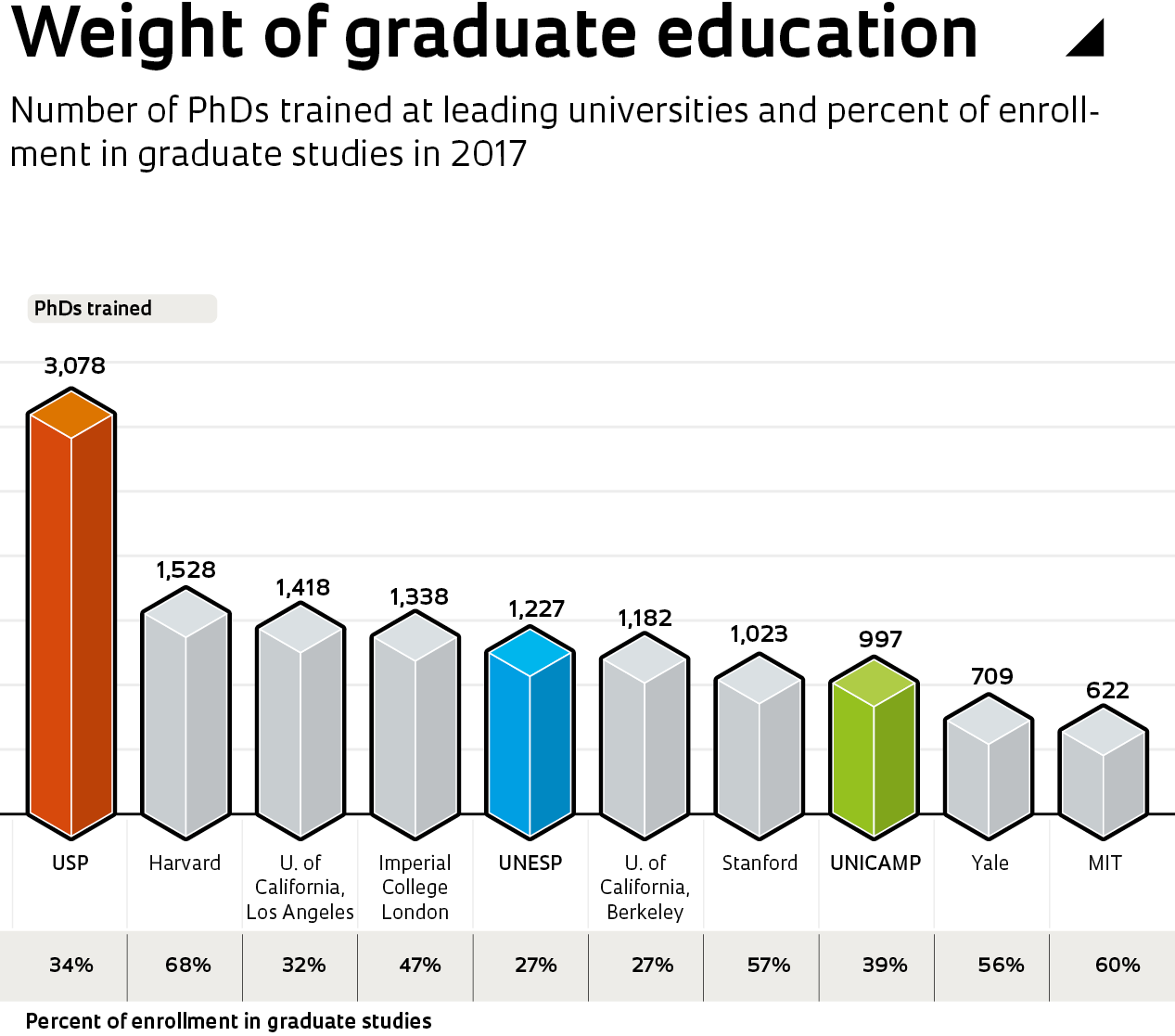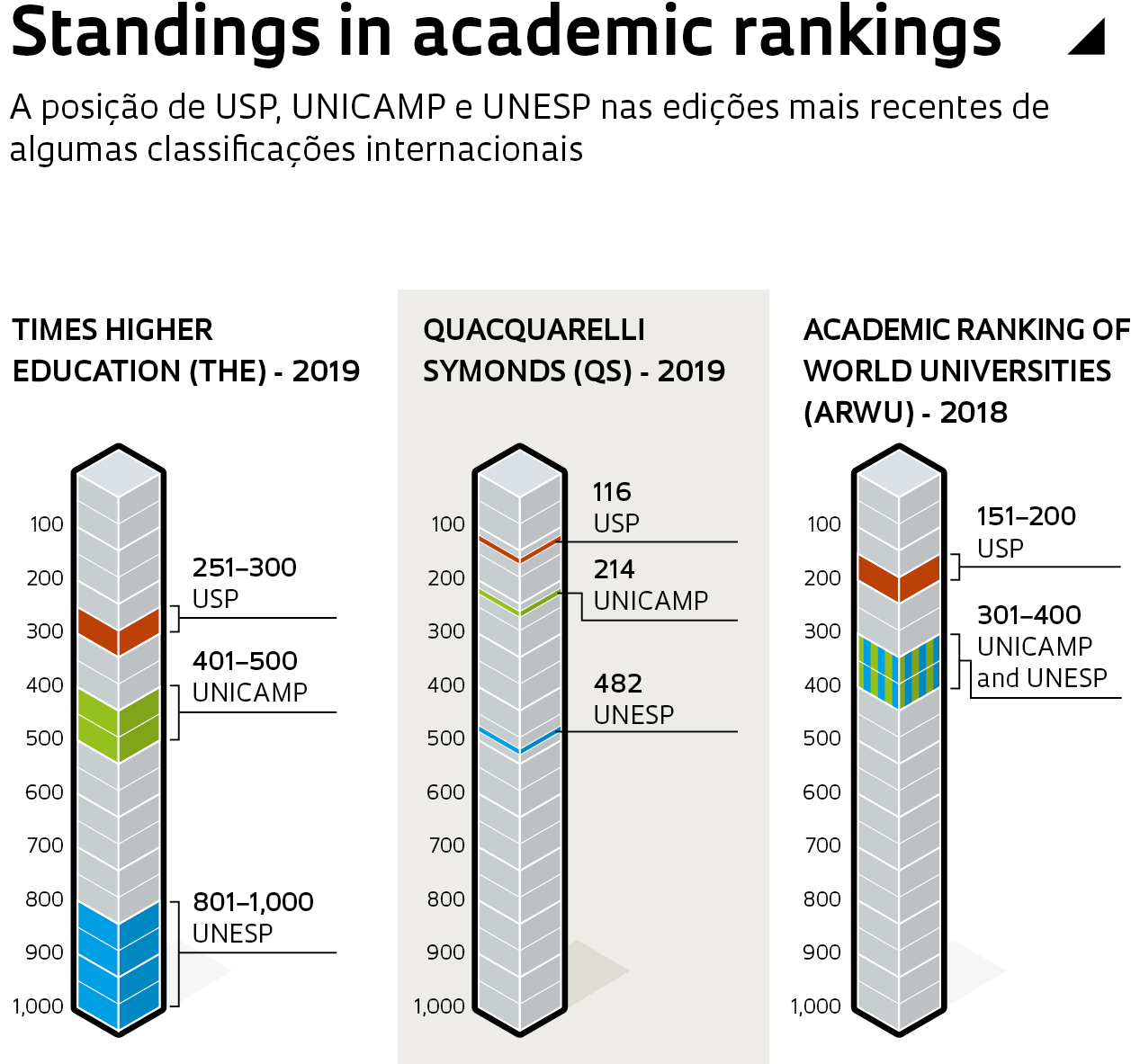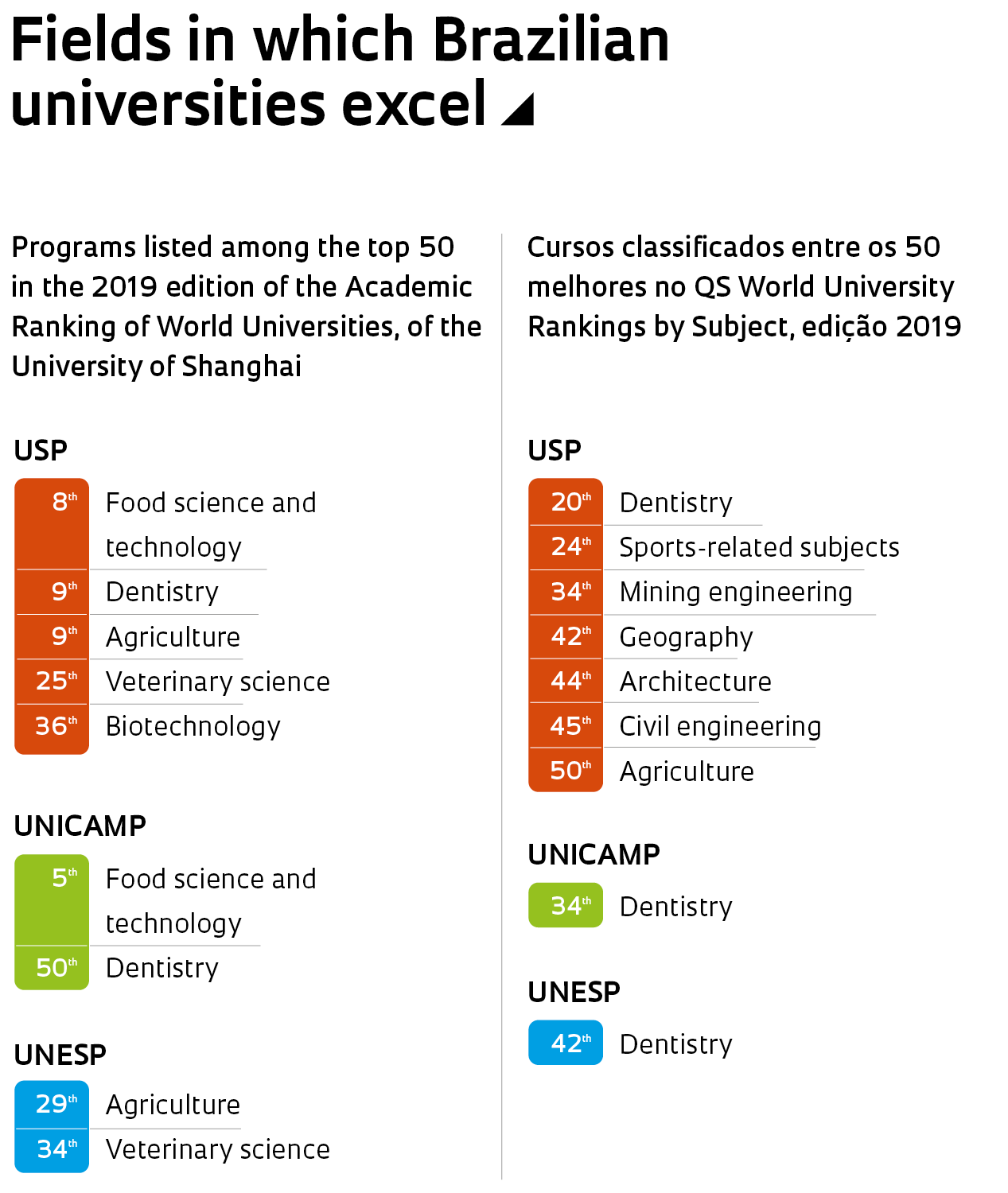The financial independence afforded to the University of São Paulo (USP), the University of Campinas (UNICAMP), and São Paulo State University (UNESP) in 1989 enabled them to secure a place among the top higher education and research institutions globally. Funding from a fixed allocation of state sales tax (ICMS) for these universities supported a 16-fold increase in research output and a 7-fold increase in doctorate degrees over the space of 30 years. A result from this investment was seen on July 17 when British magazine Times Higher Education (THE) published the latest edition of its World Reputation Rankings, based on a survey of more than 11,000 researchers and academics around the world.
USP was the only Brazilian university to rank among the top 100, sharing the 81st to 90th band with such names as the University of California at Santa Barbara, the Free University of Berlin, and the Hong Kong University of Science and Technology. Surveyed scholars were asked to pick what they considered to be the 15 top universities for research and education—half of the list is occupied by US universities. “Financial and governance autonomy was a turning point for state universities in São Paulo,” says Vahan Agopyan, dean of USP. “We are able to plan several years into the future and this has improved our indicators across the board.” The reputation ranking is one of several components of THE’s annual World University Rankings, alongside indicators for teaching, research, internationalization, innovation, and employability. In this overall ranking, USP is placed among the 300 best universities in the world, UNICAMP among the 500 best, and UNESP among the top 1,000.
– A legacy for the future
– Tools for planning the future
– Fuel for innovation
– Expanding student numbers
Jacques Marcovitch, who served as dean at USP between 1997 and 2001, says financial independence had a dramatic impact on governance at the three institutions. “It made university officials more accountable for the future of their universities, as there would be no one else to blame but them for any difficulties or challenges facing their institutions,” he says. They began to measure their performance, initially using simple indicators—such as the number of papers published—and more recently metrics that gage the scientific, economic, and social impact from their research. “Different disciplines initially attached separate weights to teaching, research, and extension activities, but later developed common metrics spanning all three dimensions,” says Marcovitch, who is leading a project to develop a system of indicators for the three universities to measure impact on development within the state of São Paulo and countrywide.

International benchmarking can be useful in revealing strengths and weaknesses, and measuring the results from efforts to stay competitive. State universities in São Paulo perform well on indicators measuring research output and the development of high-caliber professionals, but not as well when it comes to the international impact of their research—in general, citation counts have grown at a slower rate than article counts. According to a report by Clarivate Analytics, UNICAMP had a citation impact of 0.94, USP 0.93, and UNESP 0.79 between 2011 and 2016—lower than the world average of 1. “The biggest challenge facing these universities is turning their extremely high research output into high citation impact despite the absence of robust government policies rewarding impact on productivity, such as those we see in other countries, like China,” says Marcovitch.
This pattern is seen clearly in a ranking produced by the Center for Science and Technology Studies (CWTS) at Leiden University, in the Netherlands, based on indicators such as the number of articles published in English and citations. USP comes in an honorable 8th place in the overall ranking for total article counts between 2014 and 2017, ahead of US universities such as Stanford and the University of California, Los Angeles. But on the list that includes only the top articles for impact—those within the top 10% for citations—USP drops to 81st place. UNICAMP ranks 183rd by number of publications and 322nd for articles among the 10% most frequently cited. UNESP is listed in 138th place by volume and 353rd for articles with most citations. “The quality of scientific research in Brazil is heterogeneous, and universities in São Paulo still have a way to go in internationalizing their research and expanding cross-border collaborations, although they have all invested and made progress in this direction,” says José Augusto Chaves Guimarães, a professor in the Department of Information Science at the Marília campus of UNESP, who until recently was a member of the university’s Institutional Committee for Ranking Evaluation.
But with international competition, excellence is not enough. Universities need to either equal or outpace their rivals. Unlike in Brazil, central governments in many countries invest heavily in select groups of universities to keep them world class. Germany created an “Excellence Initiative” in 2005 that encourages institutions to compete for funding and promote collaboration. To date, €4.6 billion has been invested and 14 universities have earned the status of elite, and with it extra funding. In 2005 there were nine German universities among the top 200 in the World University Ranking. Today there are 22. In the 1990s, China created the C9 League, an alliance of nine universities that account for only 3% of the country’s researchers, but receive 10% of research funding and produce 20% of the nation’s publications and 20% of total citations.

Renato Pedrosa, a professor in the Department of Science and Technology Policy at UNICAMP and head of the FAPESP Program for State Science, Technology, and Innovation Indicators, points to another global trend—the emergence of smaller institutions that are strongly oriented toward innovation and technology—citing two South Korean universities as examples: the Korea Advanced Institute of Science and Technology (KAIST), a public institution, and its private counterpart, the Pohang University of Science and Technology (POSTECH). According to the Academic Ranking of World Universities (ARWU), produced by the University of Shanghai, the two Korean institutions were in the global top 400 in the early 2000s, and now rank between 76th and 100th. “These universities are fairly young—they were founded around the same time our universities gained financial independence—and are extremely dynamic and focused on international competition. This is visible in the way they have scaled the international rankings.”
While rankings may be helpful in understanding stakeholder perceptions of universities, USP dean Vahan Agopyan believes it would make little sense for Brazilian universities to devise strategies just for the sake of ranking higher in these lists. “The salaries our faculty receive need to be within the ceiling for government officials, so hiring a Nobel Prize winner to work at USP—which would earn us a better standing in the rankings—is out of the question. And it wouldn’t make sense either. With that kind of salary, I can hire 100 talented young researchers who could help sustain research excellence at our university,” he says.
Universities in São Paulo are also set apart by the wide array of disciplines they teach. “It is more difficult to improve indicators for universities with this profile than it is for, say, the Karolinska Institute in Sweden, which is dedicated to, and has gained international renown for, innovation in life sciences,” says Aluísio Cotrim Segurado, a professor at the USP School of Medicine and head of the university’s Office of Academic Performance Indicators (EGIDA).

USP, UNICAMP, and UNESP perform better in lists measuring performance in specific fields of knowledge. In the ARWU list, USP ranks 151st to 200th overall, but is in the global top 50 for disciplines such as food science and technology (8th), dentistry (9th), agriculture (9th), and biotechnology (36th). UNICAMP is placed at 300th in the overall ranking, but 5th for food science and technology and 50th for dentistry, while UNESP performs strongly in agriculture (29th) and veterinary science (34th).
The university’s strengths in agricultural science are not surprising. Brazil’s share in global scholarly output is around 2.8% overall, but 8% in agricultural science. “São Paulo’s investment in agricultural science is long-standing, and has led to the creation of institutions such as the Campinas Institute of Agriculture and USP’s Luiz de Queiroz School of Agriculture,” says Renato Pedrosa of UNICAMP. “UNESP’s presence in rural parts of the state is linked to its excellence in veterinary and crop science,” says José Guimarães. In life sciences, dentistry and biotechnology are some of the fields in which Brazil has also invested and trained a large contingent of high-caliber researchers. Pedrosa believes the country’s research capabilities have been well targeted to fields in which it has particular strengths. “Between 2014 and 2018, Brazil published the second-largest number of publications on the Zika virus and microcephaly, behind only the US, and many of the papers that were most highly cited,” he says.
The trio of universities is also known for its prowess in graduate education. In 2017, USP trained 3,078 PhDs, outperforming the world’s leading research universities in quantitative terms: Harvard trained 1,528 PhDs that year, while the University of California at Berkeley trained 1,182. UNESP (1,227 PhDs in 2017) and UNICAMP (997) have also performed impressively. “Combined, São Paulo’s three state universities account for 40% of Brazil’s doctoral degrees. In no other country does such a restricted group of institutions carry this much weight,” says Pedrosa.
Young, technology-oriented universities have surpassed Brazilian institutions in international rankings
It is in postgraduate programs that most university research takes place. This helps explain why researchers from São Paulo’s three state universities participate in 35% of Brazil’s scholarly output. USP, UNICAMP, and UNESP—the mainstays of the graduate education system created in Brazil in the 1960s—offer 12% of the country’s more than 4,000 master’s and doctoral programs. In a recent program evaluation by the Brazilian Federal Agency for Support and Evaluation of Graduate Education (CAPES), 465 programs in Brazil received scores of 6 and 7, the highest on the scale. Thirty percent of these programs are offered by state universities in São Paulo.
Pedrosa compared the cost of the graduate-intensive education at these universities to 15 world-class universities that also have more than 20% of students in master’s and doctorate programs. Average expenditure per undergraduate and graduate student is R$328,000 at Harvard, compared to just R$53,000 at USP, R$56,000 at UNICAMP, and R$38,900 at UNESP. “The more graduate-intensive the university, the higher the cost per student. But São Paulo’s three state universities are relatively low cost compared to international benchmarks,” says Pedrosa.
USP, UNICAMP, and UNESP have a funding model that is unique to them. “The decision to award a percentage of state tax revenue came as result of a culture that worked in the specific context of São Paulo State, but the financial stability it provided is also present in other major research universities around the world,” says Agopyan. In the US, universities are typically funded by endowments donated by alumni and corporations, competition for research funding, and student fees, while public universities often receive funding that is conditional on meeting specified targets. The University of California at Berkeley, a public university, had a budget of US$2.8 billion for fiscal year 2017–2018, with funding derived from a variety of sources: 33% from tuition fees, 14% from state sources, 15% from funding agencies, 9% from public or private partnerships, 10% from educational activities, 10% from donations, 5% from investments, and 4% from other sources.
France passed a law in 2007 that gave its public universities greater autonomy—they can now own their facilities and use them as collateral to secure loans. But they are required to meet targets that are measured every four years, and only institutions meeting those performance requirements are eligible for extra government funding. Vahan Agopyan believes that insight from international experience can help to perfect the funding model at state universities in São Paulo. “We can improve the system to address governance challenges stemming from fluctuation in tax revenue.”
This is the third article in a series about the financial autonomy of state universities in São Paulo during the last 30 years
Republish
